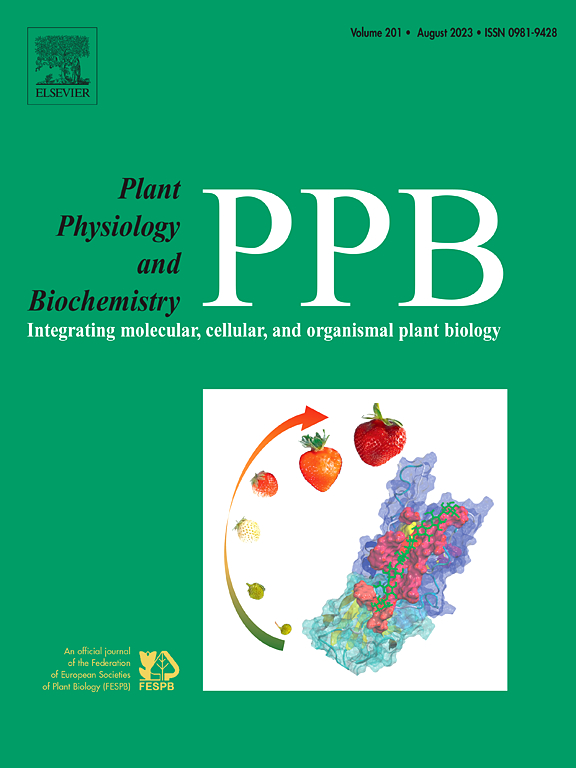Starch-sugar metabolism in response to wound stress in apple fruit
IF 6.1
2区 生物学
Q1 PLANT SCIENCES
引用次数: 0
Abstract
The sugar molecule is essential for plant response to abiotic stress. Leveraging previously obtained transcriptome data, this study investigated the changes in starch and cellulose degradation as well as sucrose metabolism in post-harvest mechanically wounded apples. The findings demonstrated that wounding up-regulated the expression levels of MdAMY1.1, MdAMY2, MdBAM1, and MdBAM3, which in turn enhanced the enzymatic activities of α-amylase (AMY) and β-amylase (BMY), thereby accelerating the degradation of total starch, amylose, and amylopectin. Conversely, it down-regulated the expression levels of MdSS3 and MdSS4, reduced the enzymatic activities of sucrose synthase synthesis (SS-s) and sucrose synthase cleavage (SS-c). Wounding also up-regulated the expression levels of cellulase and β-glucosidase genes, thus facilitating the degradation of cellulose. Moreover, wound stress induced the up-regulation of MdSPS1, MdCWINV1, MdINV∗DC4, and MdTIV1 expression levels, thereby maintaining the balance of sucrose metabolism. Consequently, this leads to an increase in the biosynthesis of glucose, fructose, sucrose, and reducing sugars at the wound sites. All these evidences indicate that starch and cellulose at wound sites are degraded to produce sugars, which facilitate the wound healing process in apple fruit, thereby helping to reduce microbial infections and minimize post-harvest losses.
苹果果实对创伤胁迫的淀粉糖代谢反应
糖分子对植物对非生物胁迫的反应至关重要。利用先前获得的转录组数据,本研究调查了收获后机械损伤苹果中淀粉和纤维素降解以及蔗糖代谢的变化。结果表明,损伤可上调MdAMY1.1、MdAMY2、MdBAM1和MdBAM3的表达水平,进而提高α-淀粉酶(AMY)和β-淀粉酶(BMY)的酶活性,从而加速总淀粉、直链淀粉和支链淀粉的降解。相反,它下调MdSS3和MdSS4的表达水平,降低蔗糖合酶合成(SS-s)和蔗糖合酶裂解(SS-c)的酶活性。损伤还上调了纤维素酶和β-葡萄糖苷酶基因的表达水平,从而促进了纤维素的降解。此外,创伤应激诱导MdSPS1、MdCWINV1、MdINV∗DC4和MdTIV1表达水平上调,从而维持糖代谢平衡。因此,这会导致伤口部位葡萄糖、果糖、蔗糖和还原糖的生物合成增加。所有这些证据表明,苹果伤口处的淀粉和纤维素降解产生糖,促进伤口愈合过程,从而有助于减少微生物感染,最大限度地减少收获后的损失。
本文章由计算机程序翻译,如有差异,请以英文原文为准。
求助全文
约1分钟内获得全文
求助全文
来源期刊
CiteScore
11.10
自引率
3.10%
发文量
410
审稿时长
33 days
期刊介绍:
Plant Physiology and Biochemistry publishes original theoretical, experimental and technical contributions in the various fields of plant physiology (biochemistry, physiology, structure, genetics, plant-microbe interactions, etc.) at diverse levels of integration (molecular, subcellular, cellular, organ, whole plant, environmental). Opinions expressed in the journal are the sole responsibility of the authors and publication does not imply the editors'' agreement.
Manuscripts describing molecular-genetic and/or gene expression data that are not integrated with biochemical analysis and/or actual measurements of plant physiological processes are not suitable for PPB. Also "Omics" studies (transcriptomics, proteomics, metabolomics, etc.) reporting descriptive analysis without an element of functional validation assays, will not be considered. Similarly, applied agronomic or phytochemical studies that generate no new, fundamental insights in plant physiological and/or biochemical processes are not suitable for publication in PPB.
Plant Physiology and Biochemistry publishes several types of articles: Reviews, Papers and Short Papers. Articles for Reviews are either invited by the editor or proposed by the authors for the editor''s prior agreement. Reviews should not exceed 40 typewritten pages and Short Papers no more than approximately 8 typewritten pages. The fundamental character of Plant Physiology and Biochemistry remains that of a journal for original results.

 求助内容:
求助内容: 应助结果提醒方式:
应助结果提醒方式:


